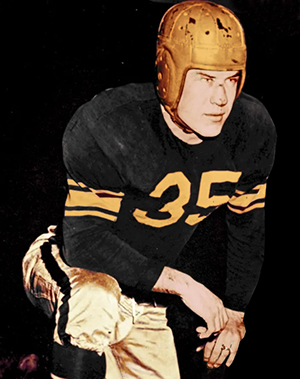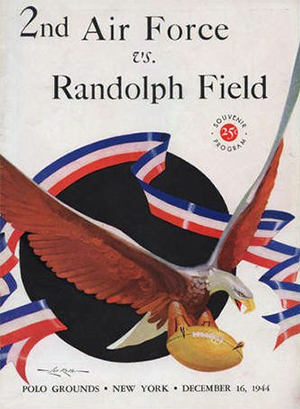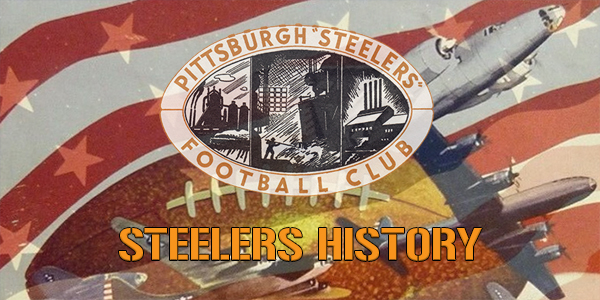Byron “Whizzer” White made all the football headlines in 1938 when Art Rooney enticed him to Pittsburgh to play professional football for a $15,000 salary. The wage was double what any player in the league had made before.
There was a very brief love affair with White, but the team’s disappointing 2-9-2 season couldn’t really be considered as a success.
The continuing poor performance of the Steelers saw them with the number one draft pick for the 1942 season and there was an outstanding athlete to use their selection on.
 Bill Dudley was the first All-American out of Virginia and was the leading scorer and ground gainer in collegiate football for 1941. His athletic prowess was recognized when he was honored with several Player of the Year awards.
Bill Dudley was the first All-American out of Virginia and was the leading scorer and ground gainer in collegiate football for 1941. His athletic prowess was recognized when he was honored with several Player of the Year awards.
Dudley could not only run the ball, but he could also throw the ball, play defense, punt, return kicks and punts, and placekick. “That’d what you were supposed to do back then,” Dudley acknowledged many years after he had retired. Although playing both ways was the norm at the time, his added skill of kicking was an exception.
Despite his outstanding ability as a player, Dudley originally had no ambition to play pro football. His future career path was to coach football.
His declared intention to forgo playing and pursue coaching didn’t put off any of the NFL teams who would have been keen to add him to their roster. Following their abysmal 1-9-1 season, it was the Steelers who had the overall number one draft pick, and they used it on Dudley.
With the nation now at war, there was a high possibility of Dudley enlisting in the armed forces before starting a new career as player or coach, but the Steelers took a chance as they were desperate to improve a team that continued to disappoint.
With many football players dressing in a different uniform and the NFL competing with Uncle Sam’s draft, the Steelers failed to surround Dudley with the supporting players he deserved.
Art Rooney’s risk in taking Dudley showed an early return when the Navy discovered they had too many recruits to train. They gave Dudley a three-month furlough that allowed him to play for the Steelers in the forthcoming season.
The Steelers began the season losing both their opening games despite Dudley contributing a 44-yard touchdown run in the 24-14 loss to Philadelphia. In the game in Washington, he tied the game with a kickoff return of 84 yards before the Steelers lost 28-14.
After those two losses, the Steelers were not despondent. Coach Walt Kiesling enthused of Dudley, “He’s the best back we ever had.” Art Rooney added, “He looks better to me than ‘Whizzer White.’
Behind Bill Dudley’s running, the Steelers finished the season 7-4 when he contributed 696 yards on the ground with five touchdowns. His 7-yard touchdown run against the Brooklyn Dodgers was the sole score in a Steelers 7-0 triumph.
Dudley was the leading rusher in the NFL that season becoming the second Steeler after Whizzer White (1938) to earn the title. He repeated the achievement again in 1946 but no Steeler has earned the title since.
Dudley wears a different uniform
Two weeks after the end of the season, Dudley found himself at Perrin Field, Texas, for his basic training with the Army Air Force.
The Armed Forces encourage their members to participate in sport and so it was with Dudley. In 1944, he found himself playing with the Randolph Field Ramblers of Texas.
Due to the strength in depth of the team, Dudley didn’t participate fully in all their games, but he still managed to produce some magic numbers.
 The Army Air Force issued Dudley’s figures for the first nine games: 595 yards on 73 rushes for an 8.2 average (including touchdown runs from scrimmage of 67, 59, 48 and 47 yards); 28 pass completions in 67 attempts for 464 yards; seven catches for 93 yards; 26 punt returns for 381 yards: two kickoff returns for 66 yards; three pass interceptions; and 17 punts for a 43.5 average. Dudley passed for nine touchdowns, scored six touchdowns, and kicked six extra points.
The Army Air Force issued Dudley’s figures for the first nine games: 595 yards on 73 rushes for an 8.2 average (including touchdown runs from scrimmage of 67, 59, 48 and 47 yards); 28 pass completions in 67 attempts for 464 yards; seven catches for 93 yards; 26 punt returns for 381 yards: two kickoff returns for 66 yards; three pass interceptions; and 17 punts for a 43.5 average. Dudley passed for nine touchdowns, scored six touchdowns, and kicked six extra points.
The Forces’ season climaxed with the Treasury Bond Bowl when the unbeaten Ramblers faced the Second Air Force Superbombers of Colorado Springs. The majority of the tickets for the game were to be purchased via the sale of war bonds priced from $25 to $100,000. The total sale of bonds for the game was projected to be $79 million.
The purchase of a bond originally entitled the buyer to pay $2.40 for a ticket until corporate interests and payroll savings groups underwrote the bond sale. The game was publicized as a duel between Dudley and the Superbombers’ Glenn Dobbs, who went on to play for the Brooklyn Dodgers in the All-America Football Conference.
Inclement weather reduced the crowd to a sparse 8,356 as the teams struggled to put any offense together as snow flurries fell. The Ramblers took a lead in the first quarter, added another touchdown in the third before the Superbombers scored a consolation touchdown in the final quarter. Although the Bombers dominated the stats it was Dudley who edged the duel with his touchdown pass and extra point kick as the Ramblers won 13-6.
When the annual football awards were handed out, Lt. Bill Dudley was honored as the outstanding service player of the year.
Within a week of being discharged in early November 1945, Dudley celebrated his return to Pittsburgh with two touchdowns while kicking the extra points as the Steelers beat the Cardinals 23-0. It was the first time they had won a home game in two seasons.
The following year, Art Rooney finally got the head coach he had been pursuing for years when he signed Jock Sutherland. After joining the organization, Sutherland acknowledged Dudley as one of the greatest backs he had ever coached. Dudley shone in preseason, but the honeymoon with his coach wasn’t going to last. Sutherland was a strict disciplinarian which is what some athletes needed to bring out the best from them.
While most pro teams had stopped using the single wing formation, Sutherland hadn’t. The team improved to 5-5-1, but the continuing pounding that Dudley endured took its toll. As one of the smallest players in the NFL, Dudley suffered more than most.
After the Dudley was carried off the field on a stretcher at the end of the season finale, he announced his retirement from football. He again led the league in rushing with 604 yards ensuring he won the MVP honor.
In January 1947, Dudley confirmed to the Steelers he wasn’t going to return. At the beginning of August that year, Dudley was traded to Detroit when he signed a $25,000 contract and played three seasons before being traded to Washington.
Years later, but before his team’s Super Bowl winning decade, Art Rooney would acknowledge that Dudley’s trade to the Lions broke his heart. “That boy was the only player I ever had that anybody ever got excited about,” Rooney said. “He was the best player I ever saw.”

